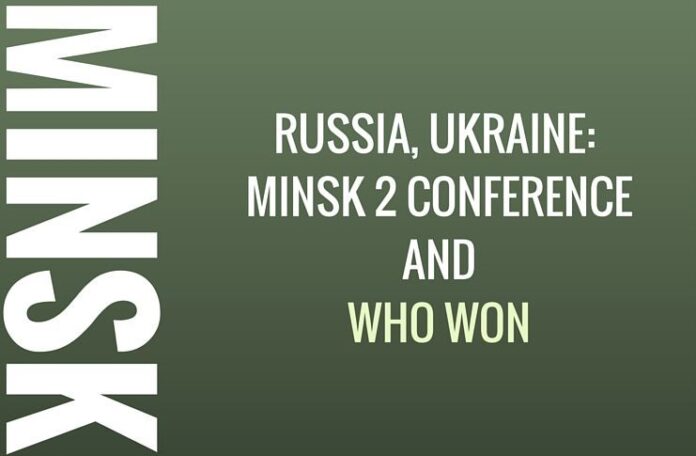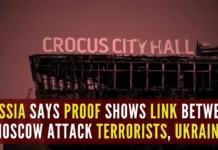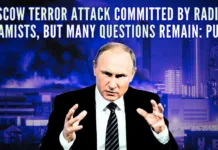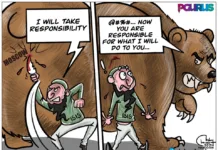
[dropcap color=”#008040″ boxed=”yes” boxed_radius=”8px” class=”” id=””]T[/dropcap]he second Minsk conference in Belarus on February 21-22, 2015 was a long seventeen-hour affair which hoped to stop the “hybrid war” between Ukraine and the Ukraine rebels, mainly Russians left in independent Ukraine. The main participants of the conference were Germany, France, Russia and Ukraine, referred to as the Normandy Quartet. To the twelve points agreed at Minsk1, a thirteenth was added in Minsk 2 to decide the constitutional fate of the Lugansk and Donbas republics1.
A comprehensive ceasefire was to be maintained from February 15. By March 1, heavy weapons were to be withdrawn and an OSCE-monitored (Organisation for Security and Cooperation in Europe) safety zone would be established, between 50 and 150 kilometers wide, between Kiev controlled areas and Eastern Ukraine. The OSCE would use drones, satellites and radar to monitor the temporary border. Kiev would grant a general amnesty to its eastern “rebels” and introduce a constitution for a united Ukraine. Both sides obtained what they wanted: Russia did not want any more Ukrainian territory, but wanted its ethnic members to have equal treatment under the Ukrainian constitution. There would be an exchange of prisoners, and economic ties with the two “republics.” The latter would have, their own militia but foreign troops would have to be withdrawn from Ukraine, language self-determination, and freedom to appoint their own prosecutors and judges. Ukraine could be pro-West and pro-Russia. Germany and France offered to give technical assistance to restore the sustainability of the banking system in Eastern Ukraine. In other spheres too, Russia said it would help Ukraine. The “contact group” members would meet often to ensure the peaceful progress of Ukraine2.
Indian ex-diplomat and now a correspondent writing for atimes.com Bhadrakumar rightly concluded that Russia won the contest between Ukraine and Russia: the Russians in Eastern Ukraine would live in a virtually autonomous territory within Ukraine. Ukraine could be aligned with the West, but it could not allow NATO within its borders. Mikhail Gorbachev felt that the Agreement was a “historic deed” since a number of regions did not recognise the Russian constitution and the Minsk 2 formula which approximated Finlandization, would satisfy dissatisfied regions in Russia’s Near Abroad. Unlike Putin’s critics, Gorbachev praised his leader, Putin, for saving Russia.
[dropcap color=”#008040″ boxed=”yes” boxed_radius=”8px” class=”” id=””]M[/dropcap]insk 2 formula for peace was fair, if it holds. Prime Minister Poroshenko would control the whole of Ukraine, excluding Crimea, provided he did not rule with a heavy hand, like introducing martial law, as he had threatened3. Foreign troops were required to be withdrawn from Ukraine. The question of Crimea being part of Ukraine could be discussed later. The peace treaty stopped the Russians in Ukraine from extending their frontiers to cities of Dnieper-Zaporozhye, Dnepropetrovsk and Kiev. Minsk 2 gave credibility to Putin’s claim that he did not intend to annex anymore territory4.
Given Minsk 2, Putin would do well to release Ukraine’s heroine, Nadia Savchenko, who is in jail and on a hunger strike. So far, she has been on a hunger strike for 82 days. She, as a helicopter pilot, has been alleged to have killed two Russian photographers. Poroshenko praised her for being a “symbol of the invincibility of the Ukrainian spirit and heroism.” Savchenko thought that she was behind bars on trumped up charges; she claimed that the photographers were killed before she was at the disputed scene5.
Those interested in the Ukrainian solution looked to other Agreements like Munich (1945) and Dayton (1995).
The Munich Agreement is associated with Sudetenland, where three million Germans were stranded. Hitler’s attack of Czechoslovakia to protect German expats was regarded as similar to Putin’s demand for protection of Russians in Easter Ukraine. Worse, Hitler regarded the Czechs as subhuman or Untermenschen. The invaders killed 300,000 Czechs, who, as Slavs, were allied to Russia. While Russia kept out of this war, the British and French sought appeasement. Hitler went on to occupy Poland and tried in vain to conquer Russia.
When World War II was over, the Czechs took revenge on the Germans who were left. In Postoloprty, 60 kms north-west of Prague for instance, 2,000 Germans were killed in the space of a few days in 1945. About 2.5 million were displaced and 19,000 died during the war. Commander of the Czech forces Sergej Ingr ordered, “Beat them, kill them, let nobody survive.” On September 29, 1938, the leaders agreed at the Munich Conference to establish “peace in our time6”. But since Hitler could not be trusted, Franklin D. Roosevelt pushed for war in 1939. According to historian Hans Vogel7 history repeated itself with the Ukrainian crisis.
[dropcap color=”#008040″ boxed=”yes” boxed_radius=”8px” class=”” id=””]F[/dropcap]or world history, important agreements took place after the Second World War that were useful for future settlements. The Czech Prime Minister Petr Neċas apologized to the Bavarian parliament for the enforced expulsion, depriving Germans of citizenship, and for using the principle of collective guilt. German Chancellor Helmut Klaus and Czech Prime Minster Vãclav Klaus years later signed the 1997 Czech-German Declaration which set up a fund to compensate displaced persons, according to the Fundamental Rights Charter of the EU’s Lisbon Treaty8. A higher body, the EU, indirectly facilitated a lasting peace between the two member countries. The Declaration was constructive and good for Europe and set an example to the world.
The US deserved credit for the 1995 Dayton Agreement that limited the Bosnian War to three years. The key to establishing peace was arming the minorities, the Muslims and Croats in Yugoslavia, against the majority Serbs who wanted to create a Greater Serbia by ethnic cleansing. On the basis of Dayton, demands to arm the Ukrainians came from some Americans and Ukrainians9. This strategy was not sound and the German leader Angela Merkel objected to it for the simple reason that the Russians were much more powerful than the Serbs and would crush the Ukrainians. Putin was cool to this strategy as he felt that the US had been arming the Ukrainians before the start of the war. Putin said that more arms to Ukraine meant more bloodshed and the end result would be the same.
The new strategy for those manipulating the Jerusalem-Kiev axis was to boost Merkel as the new leader of the free world, downplay Obama’s prestige, and carry out a relentless attack on Russia.
[dropcap color=”#008040″ boxed=”yes” boxed_radius=”8px” class=”” id=””]M[/dropcap]aclean’s, a magazine that claims to be Canada’s national magazine, March 2, 2015 edition has a front page of Merkel, and the title read “The New Leader of the Free World – Move over, Obama…” The appearance of Israeli Prime Minister Benyamin Netanyahu before Congress without consulting White House should be read in this light.
The Ukrainians joined in by blatantly distorting history: “in a recent broadcast of “Tagesthemen”, the main newscast of Germany’s ARD public television channel, Ukrainian Prime Minister Arseniy Yatsenyuk accused the Soviet Union of having invaded Germany and Ukraine.”10 This “re-writing of History” was followed by the false allegation that the USSR bombed Hiroshima and Nagasaki11. In the second instance, the Ukrainian media was trying to appease the Japanese and denounce Russia.
In support of Ukraine, Polish Minister of Foreign Affairs Gregorz Schetyna also tried to distort history by undermining Russia and praising Ukraine for liberating Auschwitz. UN Russian envoy Vitaly Churkin cleared the air by noting that the multi-national Red Army, with 100 nationalities, liberated Auschwitz on January 27, 194512. Professor of the Historical Sciences at RUDN University Valery Keroo agreed with Churkin13.
[dropcap color=”#008040″ boxed=”yes” boxed_radius=”8px” class=”” id=””]R[/dropcap]ussia had to be weakened economically. The goal was to trigger a wave of bankruptcies in Russia: the trick was to shorten the duration that loans had to be paid as the budget to cover regional loans was 180 billion rubles. Another trick was to try to deprive Russia from being a member of SWIFT, a speedy method of transferring money from one part of the world to another; previous attempts had failed14. Rating agency, Moody’s downgraded the loans of several Russian regions:
Tartarstan from Ba1 to Ba2; Bashkortostan from Ba1 to Ba2; and, St. Petersburg from Baa3 to Ba1. Pravda noted that Moody’s “junks all Russia15.”
Another method of defanging Russia was to go after Putin who was blamed for the disappearance of Malaysian airliner MH 370. A CNN aviation analyst said that Putin ordered the airliner to be flown to Kazakhstan, but he did not know why16. The use of the phrases like, “spins theory” and “True Story!” and the attempt to link Russians to the shooting down of MH17 in Ukraine, when the Russians have clear evidence that a Ukrainian pilot was responsible for the incident, show that Putin was being framed. The US Congress has been asked for $20 million for such propaganda, which seems a waste of money.
Putin is not an icon of innocence. In a communist country where equality is supposed to be the norm, he is reportedly worth $40 billion. A western businessman who claimed to have close contacts with Putin said the figure is more like $200 billion. His is a totalitarian state where governing methods are much more inhumane than those in the West.
He is consequently, directly or indirectly, responsible for the death of opposition leader Boris Nemtsov who was killed by a sharp-shooter near the Kremlin when he was on his way home around midnight of February 27, 2015. Nemtov’s mother seemed to know what was best for him. Nemtov claimed that whenever the two had a conversation, she warned him not to speak against Putin openly, else he would be killed. The West believed rightly that this was a political assassination. Nemtov, Poroshenko and Netanyahu shared the same culture and Nemtov had obtained official permission to stage a public protest for 50,000 in the capital before he died, which translated to a protest against Putin’s Administration. Head of Russia’s Security Council Nikolai Patruchev said that there was a plot to oust Putin through aid to opposition leaders. He added that “our trans-Atlantic partners have a clear goal to divide the Muslim world and to weaken Russia and China at the same time17.” Patruchev explained that this plot was similar to the “coloured revolutions” set in motion in MENA and Eastern Europe. Nemtov seemed to be the first high-profile casualty of H.R. S.2277.
[dropcap color=”#008040″ boxed=”yes” boxed_radius=”8px” class=”” id=””]P[/dropcap]oroshenko, rather than Putin, is responsible for the chaos in Ukraine. None other than the Ukrainian Patriarch wished Poroshenko good luck in killing civilians – a sarcastic remark and a sign that an immature politician was on the loose. The helplessness of Ukrainians is best illustrated when de-moralized, retreating soldiers from the surrounded city of Debaltseve took over Artmousk and demanded drinks when they could not pay; many did not have a place to sleep.18 The annual inflation rate is 34% which is a sign of huge instability.
One of the goals of the West, notes right-wing French politician Marie le Pen is to start a war by bringing NATO to Russia’s border, which Putin opposes. Le Pen adds that the present Ukrainian government was illegal since it arose from the ashes of a “revolution on the Maidan19.”
The first Deputy Head of the United Russia Party and leader of Afghan refugees Franz Klintsevich had another slant on this goal. Klintsevich said that external powers were creating a Fourth Reich to destroy Russia20 which meant boosting Germany, as “a leader of a free world.”
[dropcap color=”#008040″ boxed=”yes” boxed_radius=”8px” class=”” id=””]B[/dropcap]ut Germany, despite its post-war economic success, can be impoverished easily if countries claim compensation for German occupation during the Second World War. Israel obtained its compensation. Russia’s unofficial claim runs into trillions of dollars, and Greece’s into billions. Should others join this trend, Germany will find it difficult to meet its obligations.
If Zbigniew Brzezinski has his way, Russia would be broken into its constituent parts. As a Polish-American, he allegedly hates the Russians. He has his supporters and neo-cons who want to Balkanize Russia. The Americans are also hoping that China’s increasing commercial ties with Ukraine would separate the bond between China and Russia21.
Bibliography
- M.K. Bhadrakumar, “Russia’s Putin wins in Ukraine conflict,” atimes.com, February, 22, 2015.
- “The Minsk ceasefire deal, point by point,” rt.com, February 13, 2015; also see Pravda editor-in-chief Inna Navikova, “Minsk meeting: Putin’s power would blow Obama away,” pravda.ru, 12.2.2015.
- “Petro Poroshenko ready to declare martial law in Ukraine,” pravda.ru, February 2, 2015.
- James Meek, “What does Russia want?” lrb.co.uk, February 12, 2015.
- Trudy Rubin, “Nadia Savchenko hunger strike: female Ukrainian pilot could starve to death in Russia ‘within days,’” smh.com.au, March 4, 2015.
- B.C. “The Sudeten German Question,” economist, February 27, 2015.
- Hans Vogel, “History repeats itself,” pravda.ru, February 20, 2015.
- B.C. op. cit. see also, Ministry of Foreign Affairs of the Czech Republic, “Czech-German Declaration on Mutual relations and their future development,” mzv.cz, June 7, 2014.
- Stephen Holmes and Ivan Krastev, “Ukraine: caught in the crossfire,” arabnews.com, March 1, 2015.
- Lena Sokoll, “Ukrainian Premier’s pro-Nazi version of World War II: USSR invaded Germany and Ukraine,” wsws.org, January 19, 2015.
- Inna Novikova, “Revising history: USSR bombed Hiroshima and Nagasaki?” pravda.ru, February 2, 2015.
- “Rewriting history? Polish Prime Minister says Ukrainians liberate Auschwitz, Russia puzzled,” rt.com, January 22, 2015.
- “Poland humiliates Russian history to appease Americans,” pravda.ru, February 2, 2015.
- “Financial War: USA tries to trigger a wave of bankruptcies of Russian companies,” pravda.ru, February 25, 2015.
- Elizabeth Polskaya, “Moody’s junks all of Russia,” pravda.ru, February 26, 2015.
- Michael Koziol, “MH 370 flew to Kazakhstan: Jeff Wise outlines new theory,” smh.com.au, March 4, 2015; also see “True Story! MSM spins theory that Putin hijacked MH 370 and landed it in Kazakhstan,’ rt.com February 25, 2015.
- Evgenia Pisneuriaya & Henry Meyer, “Russia accuses U.S. of plot to oust President Vladimir Putin via opposition aid,” smh.com.au, March 5, 2015.
- “The New York Times: demoralized Ukrainian soldiers boozing and looting after retreat,” pravda.ru, February 20, 2015.
- “Marie Le Pen: NATO wants war in Europe by bringing NATO to Russia.” pravda.ru, February 6, 2015.
- Inna Novikova, “USA creates the Fourth Reich to destroy Russia,” pravda.ru, February 9, 2015.
- “Francis Boyle: Brzezinski wants to break up Russia into its constituent parts,” pravda.ru, February 16, 2015.
- Part2 – China’s Road to Superpower status - July 20, 2017
- Part1 – China’s Road to Superpower status - July 18, 2017
- P2 – Can or should Qatar be ostracised? - June 29, 2017










